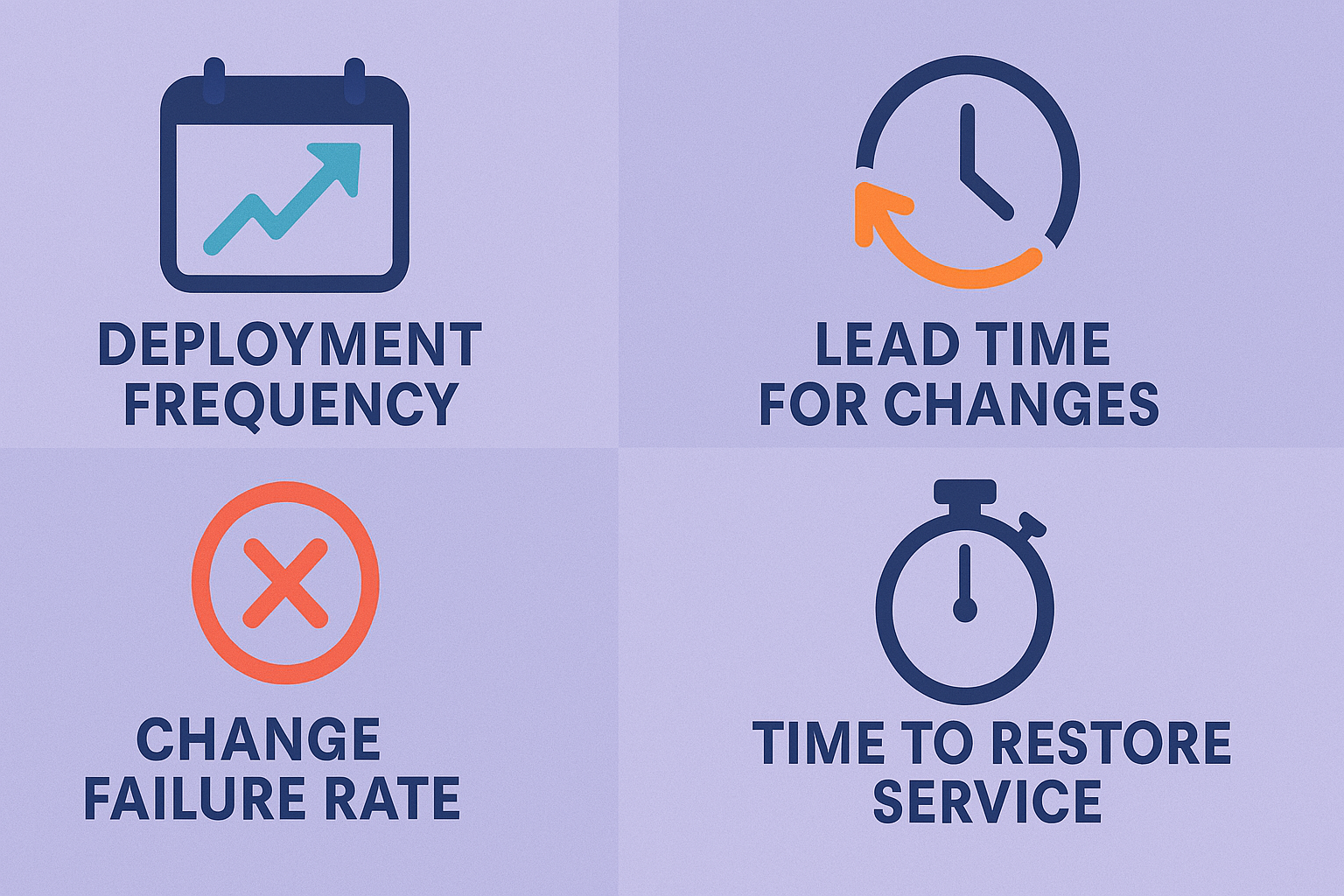The Ultimate Guide to DORA Software Metrics: What They Are and Why They Matter

Why Metrics Matter to Engineering Leaders
In 2025, engineering teams are building faster than ever with AI-assisted development cycles, product-led growth, and remote-first collaboration are the new norm. With such pace and complexity, one truth remains: you can’t improve what you don’t measure. And that’s where DORA software metrics come in.
Developed by the DevOps Research and Assessment (DORA) team and popularized by the book Accelerate, these metrics are no longer just a DevOps badge they’ve become a north star for high-performance engineering orgs. For CTOs, VPs of Engineering, and Engineering Managers, DORA metrics offer clarity: are we delivering software effectively, safely, and in ways that move the business forward?
Unlike vanity metrics, DORA’s four core indicators(change failure rate, lead time for changes, mttr, deployment frequency) correlate with business performance helping fast-moving teams balance speed with resilience, especially in environments where deploying 20 times a day is no longer rare.
In this guide, we’ll explore what each metric means, why it matters, and how you can use it to align modern engineering practices with high-level business outcomes.
The Four DORA Metrics: What They Measure and Why They Matter

1. Deployment Frequency
How often your team ships code to production.
In today's continuous deployment environments, this is a proxy for developer flow, release confidence, and user value delivery. If you're not shipping frequently, you’re delaying feedback, learning, and business impact. Elite engineering teams aim for daily or on-demand deployments, supported by automation, feature flags, and robust rollback strategies.
2. Lead Time for Changes
The time it takes for a commit to go live in production.
Lead Time reflects engineering velocity not just how fast your team codes, but how efficiently your pipeline moves ideas to users. In product-led teams, it's critical for iteration speed and customer responsiveness. If your lead time is long, you're slow to learn. The best teams monitor this to optimize CI/CD, code reviews, and deployment workflows.
3. Change Failure Rate (CFR)
The percentage of deployments that result in incidents or require fixes.
CFR is your early warning system for quality drift. As AI-generated code becomes common, and teams push more frequently, measuring how often things break keeps velocity honest. Lower CFR means better testing, tighter feedback loops, and stable production even with many changes.
4. Mean Time to Recovery (MTTR)
How long it takes to restore service when a failure occurs.
Failures are part of modern software delivery but resilience is what separates good teams from great ones. MTTR captures your team’s ability to detect, respond to, and learn from incidents. Fast recovery time signals strong observability, ownership, and incident response discipline.
Together, these four engineering KPIs: Deployment Frequency, Lead Time, Change Failure Rate, and MTTR create a well-rounded picture of software delivery performance. They help CTOs and engineering managers make informed, strategic decisions grounded in data, not gut instinct.
Why These Metrics Are Critical to DevOps and Business Success
DORA metrics are a bridge between engineering and business strategy. Here’s how:
- Faster Innovation (Deployment Frequency & Lead Time): Frequent, fast releases enable rapid iteration, helping your company respond to market shifts and user needs in real-time.
- Improved Reliability (Change Failure Rate & MTTR): Stability builds trust. Lower failure rates and faster recoveries minimize customer pain and reputational risk.
- Operational Efficiency: DORA metrics expose bottlenecks and inefficiencies. Improving them often leads to reduced waste, better resource utilization, and higher team morale.
- Executive Alignment: These metrics allow CTOs to speak in business language. Instead of saying “we’re doing DevOps,” you can say “we’ve cut delivery time by 70%, enabling faster time-to-value.”
Research by Google Cloud shows that elite performers on DORA metrics are 2x more likely to exceed organizational goals related to profitability, productivity, and customer satisfaction.
Are DORA Metrics Relevant? What Startups & Modern Teams Actually Need
Startups and modern product teams are optimizing for momentum, learning, and customer impact. Here's how DORA fits today's context:
- Lean Teams, Big Ambitions: With 5–10 engineers shipping entire platforms, DORA helps prioritize what matters. For example, if your Lead Time is high, it’s likely not a people issue, it’s tooling or review bottlenecks.
- AI-Accelerated Development: When AI can generate code instantly, DORA helps teams stay grounded: is that code getting to production efficiently, safely, and with measurable outcomes?
- Micro-deployments & Feature Flags: Many modern teams deploy small changes behind flags multiple times a day. DORA’s Deployment Frequency becomes a health check for continuous delivery culture.
- Async, Remote-First Teams: DORA offers async visibility into flow. Engineering managers can see where things get stuck, no need for micromanagement or constant check-ins.
- Tooling Matters: Whether you're using GitHub Actions, Vercel, or LaunchDarkly, DevDynamics can pull and unify these data points into a real-time DORA dashboard. That turns metrics into a diagnostic engine.
Case Study: How Engineering Teams Use DORA Metrics to Win
Socly.io, a startup in the compliance space, used DORA metrics to identify quality gaps and achieved a 37% improvement in Change Failure Rate, strengthening customer trust.
Read more - https://devdynamics.ai/blog/socly-elite-dora-status/
Deep Dive Articles: Your Next Step in implementing DORA metrics
This guide is just the beginning. Check out these spoke articles to go deeper:
- Deployment Frequency: How to Increase Without Breaking Things
- Lead Time for Changes: Diagnosing and Fixing Bottlenecks
- Change Failure Rate: Build Quality into Every Release
- Mean Time to Recovery: Strategies to reduce downtime
Each article offers actionable insights for engineering leaders ready to operationalize DevOps excellence.
Are DORA metrics only for DevOps teams?
Not at all. While born from DevOps research, these metrics apply broadly to software engineering, platform teams, and product engineering orgs.
Is DORA relevant for Startups?
Yes especially with DevDynamics as we pull metrics from Git, CI/CD, and incident tools. Even an early-stage team can benefit from visibility.
The goal of looking at metrics is not to excel at any particular metric but to really evaluate if we are improving over time. These metrics serve as guiding light.
How often should we review DORA metrics?
Ideally, continuously with trend analysis every sprint or quarter. Dashboards help you go from gut feeling to data-informed ops.
What’s the difference between DORA and SPACE metrics?
DORA focuses on delivery outcomes (speed and stability). SPACE expands into collaboration, satisfaction, and developer experience they complement each other.
Conclusion: A New Standard for Engineering Performance
If you’re serious about building a high-performing engineering organization, DORA software metrics are non-negotiable. They give you clear visibility, drive continuous improvement, and align engineering execution with business results.
Whether you're leading a product-led startup or scaling a platform team, these metrics help you answer:
Are we improving?
Are we delivering effectively, and is it making us better as a business?
Ready to embark on a journey of continuous improvement?
Start by benchmarking your team with the real-time DORA dashboard on DevDynamics built specifically for modern, high-velocity engineering orgs.
Understand your deployment frequency, lead times, and failure rates and turn insights into outcomes.

